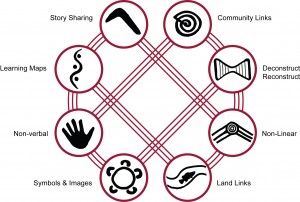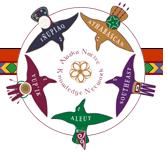8 Ways
I came across this site while searching “aboriginal education”. It is a site designed and maintained by the Western New South Wales Regional Aboriginal Education Team and James Cook University in Australia. It is a pedagogical framework for teachers to be able to teach Aboriginal students in a meaningful way. It discusses and has resources about Aboriginal perspectives and how to include them into the core curriculum that is set by the school boards and governments.
October 11, 2010 No Comments
Alaska Native Knowledge Network


This site states its purpose as “resources for compiling and exchanging information related to Alaska native knowledge systems and ways of knowing.” There are lot of resources concerning curriculum, information on cultural research systems, and cultural maps.
October 11, 2010 No Comments
New South Wales Aboriginal Ed
Here’s a site from the New South Wales Government in Australia. It is dedicated to Aboriginal Education. It provides examples of context-based teaching and learning projects to be used. It is obvious that the values of the Aboriginal people are considered. They address Aboriginal art and languages, and contextualize math, science, and literature for the students.
October 11, 2010 No Comments
Classroom English will be the death of Aboriginal languages
This Australia-based article discusses concerns around reducing the amount of time spent teaching in the local (Aboriginal) language down to a mandated one hour/day. Several reasons for doing so are listed, including the argument that Aboriginal employment is very low because education levels are very low because education is primarily conducted in English. It is argued that forcing students to learn in English will increase English literacy rates along with providing students with an education.
The author of this article disagrees with this strategy, noting that there are flaws in the logic, including the fact that low education levels are not the only reason for low employment. There are other reasons that can be cited, such as bureaucratic regulations requiring completion of literacy courses prior to gaining access to certain jobs.
Some of the areas of concern cited for moving to a one hour a day education in English are:
- Poor attendance will likely become lower
- Parental support may drop
- Turnover of teachers may increase
- Indigenous languages are further at risk
The article goes on to discuss the importance of preserving Aboriginal languages.
For those interested, several responses to the article follow it.
http://www.crikey.com.au/2008/11/20/classroom-english-will-be-the-death-of-aboriginal-languages/
September 25, 2010 1 Comment
Tradition and Literature
I came across the “Using First Nations Traditional Literature in the Classroom” site. It is created by the Saskatoon Public Schools Online Resources Centre. It provides educational resources to teachers. There are outlined activities for oral tradition, examining folklore, and story-telling. These are all important aspects to First Nations culture. This site helps to keep those alive for students and teaches them about those traditions. This can be useful to help educators incorporate tradition and culture into the classroom.
September 19, 2010 No Comments


